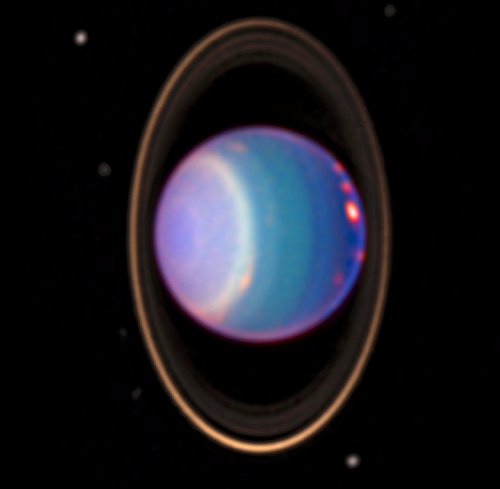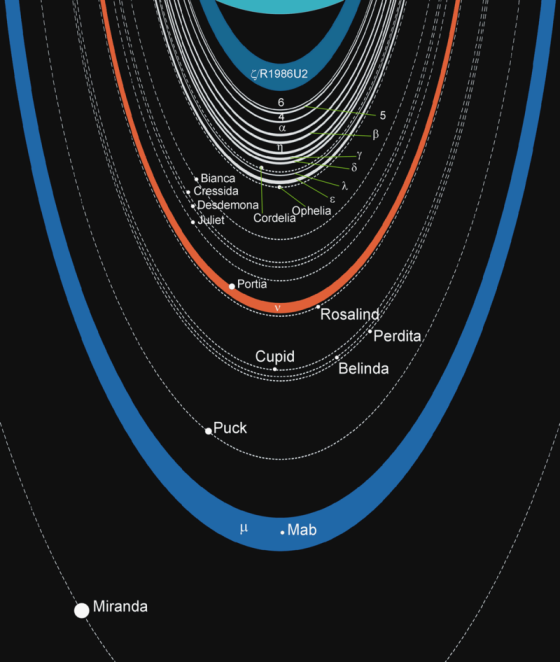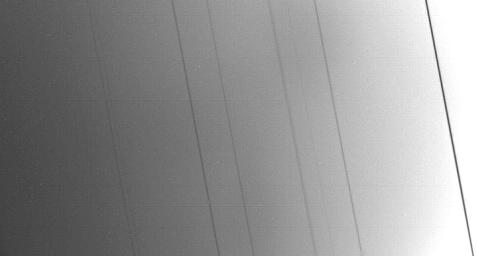New look at Voyager data indicates that Uranus may have two more moons

-
This Hubble Space Telescope image of Uranus shows the planet surrounded by its four major rings and by 10 of its 27 known satellites. The false-color image was generated by Erich Karkoschka using data obtained by Hubble’s Near Infrared Camera and Multi-Object Spectrometer. Image courtesy NASA, Jet Propulsion Laboratory, Space Telescope Science Institute
Researchers at the University of Idaho say that Uranus, the distant gas giant known for being tipped by 90 degrees, might have two more moons than has previously been thought.
UI physics graduate student Robert O. Chancia and an assistant professor of physics at the university, Dr. Matthew M. Hedman, analyzed data obtained when Voyager 2 transmitted radio waves through Uranus’ rings.
They also looked at changes in the amount of light from distant stars that moves through the planet’s ring system.
Chancia and Hedman found that patterns in the distribution of ring material near the edges of Uranus’ alpha and beta rings vary over time, indicating that small moons may be present.
Dr. Richard G. French, a professor of astrophysics and director of the Whitin Observatory at Wellesley College in Massachusetts, said in an email message that the two UI scientists essentially used a meticulous process of comparison to determine that the pattern was caused by moons.
“Chancia and Hedman compared the wavelike properties from ring profiles taken at slightly different times and different geometries to work backwards to infer the properties of a nearby moon that might produce the satellite wakes,” he wrote.
Hedman pointed out that the results obtained when ground-based receiving stations interpreted the patterns of radio waves after they passed through the two rings shows that the waves were diffracted to varying degrees.
“When you look at this pattern in different places around the ring, the wavelength is different — that points to something changing as you go around the ring,” Hedman said. “There’s something breaking the symmetry.”
The researchers concluded that two possible small moonlets close to Uranus may be the culprits.
“We find for both rings that a moonlet located about 100 [kilometers] exterior to each ring could cause the optical depth variations seen in their occultation scans,” they write in the paper.
French explained that the proposed moons would be quite close to the alpha and beta rings.
“In this case, both moons are slightly exterior to the rings, so they orbit slightly more slowly than the rings themselves,” he wrote in an email message. “As the ring particles pass the moon, their orbits are slightly perturbed, resulting in a ripple pattern within the ring that is detectable as a periodic wavelike structure.”
Those “moonlet wakes” would help to maintain the structure of the Uranian rings, keeping them narrow. The rings are composed of a huge number of tiny particles, which eventually spread out as collisions between them occur.
Moons near the rings can limit that effect.
French used the example of the planet that may be the solar system’s most famous example of a ring system to explain that a phenomenon called resonance could account for the confining impact of small moons.
“If you are orbiting Saturn, for example, and you are a little ring particle and you orbit Saturn seven times and the little moon Prometheus six times in that same interval, that’s like getting pushed by the little finger on the swing,” he said. “That little push might be teeny but collectively is powerful. That’s kind of the notion that Matt and his student came up with. Those moons are in the right place to produce this wave pattern inside the rings.”
Chancia said in an email message that he and Hedman are not certain that such moonlet wakes occur in Uranus’ alpha and beta rings.
“We really just wanted to point it out as a possibility, because no one has come up with a universally accepted solution to how these rings are confined,” he wrote. “Anyway, the structures we found look like moonlet wakes.”
If they exist, the two moons would be Uranus’ smallest known and would have a diameter of four to 14 kilometers.

-
This diagram shows the Uranian ring scheme. Solid lines depict the rings, while dashed lines indicate the orbital paths of satellites. Graphic courtesy Wikimedia.

-
This silhouetted image of the rings of Uranus was taken by the Voyager 2 spacecraft on Jan. 24, 1986. A half-second exposure was made with the wide-angle camera at a distance of 63,300 kilometers (39,300 miles). This image shows the nine originally known rings appearing as dark lines against the brighter clouds of the planet. The most prominent ring, called epsilon, appears at the right; barely visible at the left are the three rings known simply as 4, 5 and 6. The resolution of the image is about nine kilometers (five miles). Image courtesy NASA, Jet Propulsion Laboratory.
The proposed moons, if they are there, were not seen by Voyager 2’s cameras. One reason is that the moons are likely so small that the 1970s-vintage equipment could not detect them.
“[G]iven the small predicted sizes of the ∝ and ß moonlets, a convincing detection may not be possible in the Voyager 2 images,” wrote Chancia and Hedman in their paper.
The two newly-hypothesized Uranian moons may also have a very low albedo, which would make imaging of them difficult. Like the rings to which they are adjacent, they would not reflect much sunlight because the material from which they are constructed is not especially reflective.
“We know that the Uranian rings are dark because we can compare the amount of light they block during a stellar occultation – a measure of how much material there is in the rings – with how bright they are in reflected sunlight,” French wrote in an email.
“The answer is that they are quite dark – they are not composed of pure water ice, and it’s likely that they are darkened by dust contamination and perhaps by charged particles in the Uranian environment.”
French explained that the two moons proposed by Chancia and Hedman are likely to exhibit the same characteristic.
“If the satellites are dark, too, then they are stealth objects,” he said. “They are also bloody far away.”
Uranus has 27 known moons, all named for literary characters in William Shakespeare’s plays, and 13 rings that have widths between one and 100 kilometers.
The planet’s ring system was discovered in 1977 by ground-based observers using the Kuiper Airborne Observatory.
Voyager 2 was launched in 1977. Voyager 1, a twin outer solar system probe, was sent into space the same year. The latter has now left the solar system and Voyager 2 is likely to do so within the next few years.
The Chancia and Hedman paper is to be published in The Astronomical Journal and appears online at ArXive.
Update, Oct. 26, 2017, 2:42 pm MDT: The word “part” was changed to the word “particle” in a quote by Professor Richard G. French in order to reflect the correct quotation.


